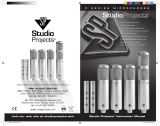
AUDIOPHILE 192 PCI
user guide
Pulsar
small-capsule
condenser microphone
care & usage
English
User Guide

3
English
Introduction
Thank you for purchasing the Pulsar microphone from M-Audio. Please take a few moments to familiarize
yourself with your new microphone by reading this guide.
Features
< Top-address cardioid instrument microphone
< 3/4” diameter 6-micron evaporated-gold diaphragm
< Solid brass body and capsule
< 20Hz-20kHz frequency response
< Class A FET electronics
< 3-pin XLR (phantom-powered)
< Includes soft case, pop filter, and hard mount
Important: Please fill out and mail your warranty card for the Pulsar so that we may provide you with support
for your microphone.
Unpacking
The container for your microphone was carefully constructed for protection during shipping. Please save this
packaging for storage or traveling with your Pulsar microphone. If your box does not include the following items,
please contact your dealer immediately:
< (1) M-Audio Pulsar microphone < (1) hard mount
< (1) soft case < (1) pop filter
Connections and Phantom Power
The M-Audio Pulsar microphone outputs a balanced low-impedance signal. It is designed to be connected to the
mic-level inputs of a mixer channel or a dedicated high-quality preamp such as M-Audio’s DMP3 or TAMPA.
As with all condenser microphones, your Pulsar requires power in order to operate. You will need to connect
the Pulsar via XLR connection to a preamp or mixer channel input that supplies +48V phantom power. (Phantom
power shares the same XLR cable as the audio from the microphone). In order to avoid pops and surges that can
damage components like speakers and microphones, always perform the following steps (in the order listed)
when connecting the mic and/or cable:
1. Turn the volume/gain on your preamp and/or mixer all the way down.
2. Make sure that phantom power is turned off.
3. Connect the microphone via a high-quality XLR cable.
4. Turn on phantom power.
5. Slowly turn up the gain on your preamp and/or mixer.
Before disconnecting the mic and/or cable, repeat steps 1 and 2 (in the order listed).
Applications
The Pulsar’s clean electronics combine with an all-brass capsule to produce a smooth tone that makes it a great
instrument-recording microphone. Use it on acoustic instruments, wind instruments, as an overhead drum mic
or room ambience recording mic. When you’re ready to add more pro-quality microphones to your mic locker,
be sure to check out the increased vocal punch of the M-Audio Luna and the multi-pattern recording features of
the M-Audio Solaris microphone.
Cardioid Pattern
Cardioid is the most commonly used polar pattern engineered into microphones.
This design causes the back of the microphone to reject incoming sound, allowing the engineer to isolate the
signal source from other performance elements or background noise by just pointing the mic at the sound
source. The logo side of the microphone is the “live” side.
Pulsar Small-Capsule Condenser Microphone Care and Usage •
English

4
Care of Your Microphone
Here are a few tips for care of your Pulsar microphone:
< Never subject the Pulsar to physical shock.
< Always use a stand—and always use the included hard mount when securing to a stand.
< Always wipe the Pulsar exterior down with a soft dry cloth and return it to its case after each use to
prevent damage from dust.
< In the event that your Pulsar needs more extensive cleaning, lightly dampen a soft cloth with water or
mild household soap and clean the metal exterior, wiping it completely dry when finished. Never spray
a cleaning agent on the microphone itself, as the moisture can damage the unit.
< Avoid subjecting the Pulsar to any kind of moisture. In vocal applications, use a windscreen to protect the
diaphragm from breath condensation and saliva build-up.
< Never disassemble the Pulsar microphone. There are no user-serviceable parts inside.
< Always use top-quality cables in order to avoid electrical problems that may damage the microphones
electronics.
< Avoid temperature extremes above 95°F and below 50°F. In order to avoid harmful moisture condensation
on the diaphragm, allow the microphone to acclimate to room temperature before connection when
moving the microphone between outdoor and indoor environments.
Specifications
< Type: small diaphragm condenser
< Polar Pattern: cardioid
< Frequency Response: 20Hz – 20kHz
< Sensitivity: 13.8 mV/Pa (-37dBV re 1V/Pa)
< Max. SPL for 0.5% THD: 134dB
< Equivalent Noise Level: 17dB A-weighted
< Output Impedance: 200 Ω
< Recommended Load Impedance: > 1,000 Ω
< Preamp Topology: Class A FET, transformerless
< Power Requirement: 48V phantom power
< Connector: 3-pin male XLR
< Dimensions: 22mm (0.87”) dia,, 132 mm (5.20”) long
< Weight: 115 g (4.0 oz)
Warranty Terms and Registration
Warranty Terms
M-Audio warrants products to be free from defects in materials and workmanship, under normal use and
provided that the product is owned by the original, registered user. Visit www.m-audio.com/warranty for terms
and limitations applying to your specific product.
Warranty Registration
Thank you for registering your new M-Audio product. Doing so immediately both entitles you to full warranty
coverage and helps M-Audio develop and manufacture the finest quality products available. Register online at
www.m-audio.com/register to receive FREE product updates and for the chance to win FREE M-Audio gear.
• Pulsar Small-Capsule Condenser Microphone Care and Usage

16
050119_PULSAR_UG_02
www.m-audio.com
060817_PULSAR_UG_EN01
/

